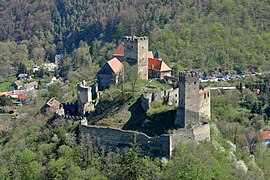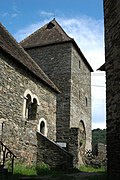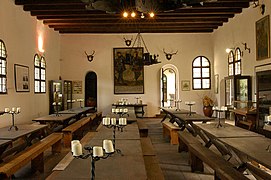Hardegg Castle
| Hardegg Castle | ||
|---|---|---|
|
Hardegg Castle |
||
| Creation time : | around 1145 | |
| Castle type : | Hilltop castle | |
| Conservation status: | receive | |
| Place: | Hardegg | |
| Geographical location | 48 ° 51 '16 " N , 15 ° 51' 27" E | |
|
|
||
The Hardegg Castle is a hilltop castle in the town of Hardegg in Thayatal in Lower Austria .
history
Hardegg was first mentioned in 1145 in a certificate from Elisabeth von Schleunz, and “Otto de Hardeck” is cited as a witness to the donation. But there was already a small weir system beforehand. The first owners were the Counts of Plain and Hardegg .
After this family died out, the castle had different owners such as the Magdeburg-Hardegger. Among them, the castle expanded significantly until it was one of the largest in the country. There were a tower, a palace built and a chapel. The castle served as the administrative center of the County of Hardegg, which can be traced back to 1294. At the end of the 15th century, the County of Hardegg was directly part of the empire . The power of the lords of the castle was based on numerous knightly followers in the localities; The main towns in the county administered from Hardegg were Pulkau and Retz, which was founded between 1280/1305 . After the death of childless Michael, Count of Hardegg and Burgrave of Magdeburg, the castle passed into the possession of the Habsburgs , who in 1499 passed it on to the Magdeburg heirs, the Prüschenk brothers, Freiherr von Stettenberg, hereditary taverns ob der Enns and Truchsessen in the Styria, pass on. At the same time, the two were appointed imperial counts of Hardegg and Machland. In 1501 Ulrich von Hardegg acquired the county of Glatz from his later brothers-in-law, Albrecht , Karl and Georg von Münsterberg, and with it the title of Count of Glatz . In 1502 Heinrich and Sigmund received the silver right to mint.
In the middle of the 17th century the castle changed hands again and came into the possession of the Counts Khevenhüller , who from 1730 took their main residence at Riegersburg Castle . Since then the castle has hardly been inhabited and fell into disrepair. When the town of Hardegg burned down in 1764, the residents were allowed to use stones and wood from the castle to rebuild their houses.
From 1878 Johann-Carl von Khevenhüller , who also became known as a fighter of Emperor Maximilian of Mexico against the troops of the republican Mexican government, had the fortress rebuilt and a family crypt installed under the castle chapel. Carl Gangolf Kayser , who was the imperial court architect in Mexico from 1864–1867 , provided the plans . A museum was set up in the castle in honor of Emperor Maximilian.
In the 20th century the castle was inherited by Count Pilati von Thassul zu Daxberg, to whom it - together with Riegersburg Castle - still belongs.
Views
Film set
- Burg Hardegg was 2014 filming location for the TV - historical film The Secret of the midwife .
- In 2018, the castle served as a filming location among others in the Waldviertel for the film Narcissus and Goldmund , directed by Stefan Ruzowitzky .
Surroundings
Neighboring castles and palaces are the Riegersburg Castle , the Kaja Castle , the Fronsburg Castle and in the Czech Republic the Nový Hrádek (Neuhäusel) ruins .
literature
- Dehio: Lower Austria - north of the Danube . Berger, Horn / Vienna 1990, ISBN 3-7031-0652-2 .
- Castles, monasteries and chateaus in the Waldviertel, Danube region, South Bohemia, Vysočina and South Moravia regions. Destination Waldviertel, Zwettl 2007, ISBN 978-3-9502262-2-5 , p. 45 ff.
- Patrick Layer (Ed.): Hardegg Castle: Origin - Shape - History of the most important count castle in Lower Austria. Verlag Günther Hofer, Retz 2008, ISBN 978-3-902111-27-2 .
- Jiří Kacetl, Petr Lazárek, David Molík: Hrady a zámky moravsko-rakouského Podyjí slovem / Castles of the Austro-Moravian Thaya Valley in words. Znojmo / Znojmo: South Moravian Museum in Znojmo in collaboration with the Retz City Museum, 2013, ISBN 978-80-86974-12-5 , Hardegg , pp. 60–65, online: Castles and palaces of the Austro-Moravian Thaya Valley , Czech / German , (PDF; 43 p., 1.7 MB), accessed December 26, 2019.
Web links
- Hardegg Castle
- Entry on Hardegg in the scientific database " EBIDAT " of the European Castle Institute
- Entry about Hardegg Castle on Lower Austria Burgen online - Institute for Reality Studies of the Middle Ages and Early Modern Times, University of Salzburg
- Entry via Hardegg Castle to Burgen-Austria
- Lord of the castle hopes for a “siege”. In: Kurier , June 23, 2019
- Photos: Hardegg Castle. In: mapio.net
Remarks
- ↑ According to the literature cited here by Boček von Jaroslavice and Zbraslav , it was merged with the County of Pernegg in 1255 or later, so it must have existed before.
Individual evidence
- ↑ Special show for the 100th anniversary. Hardegg Castle Museum celebrates. In: orf.at , March 21, 2006, accessed December 26, 2019.
- ^ History of Hardegg Castle. ( Memento from August 30, 2016 in the Internet Archive ). In: riegersburg-hardegg.com .
- ↑ Photos: Hardegg. In: Brucki's hodgepodge , July 24, 2016.
- ^ Ruzowitzky filmed Hesse in the Waldviertel. In: ORF.at , February 5, 2017, accessed on December 26, 2019.







